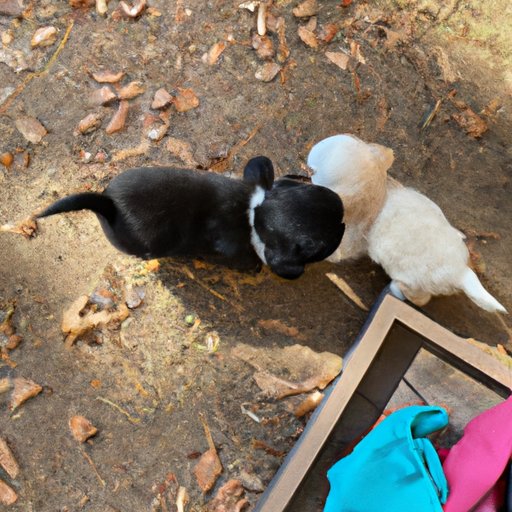
I. Introduction
As a puppy parent, you know how important it is to keep your furry friend healthy and happy. One of the key ways to accomplish this is by providing your puppy with the exercise they need. But how much exercise does a puppy need, exactly? In this article, we’ll explore the ins and outs of puppy exercise, covering everything from general guidelines to expert opinions to breed-specific recommendations.
II. How Much Exercise Does Your Puppy Really Need?
Before we get into the specifics, it’s important to establish why puppy exercise matters in the first place. Proper exercise plays a crucial role in helping puppies develop strong muscles and bones, maintain a healthy weight, and establish good behavior habits. So, how much exercise does your puppy need? As a general rule of thumb, puppies need about 5 minutes of exercise per month of age, up to twice a day. For example, a three-month-old puppy would need about 15 minutes of exercise, twice a day. However, it’s important to keep in mind that these are just general guidelines. Factors like breed, individual energy level, and health issues can all influence a puppy’s exercise needs. To get a better sense of what your puppy needs, it’s a good idea to consult with your veterinarian or a qualified dog trainer.
III. The Importance of Exercise for Puppies: Experts Weigh In
But why does exercise matter so much for puppies? According to veterinarians and other experts, there are a variety of reasons. For one, exercise helps to burn off excess energy that might otherwise manifest in destructive behavior. It also releases endorphins, which can help boost puppies’ moods and reduce stress. Additionally, regular exercise can help to prevent health problems down the line, like hip dysplasia and obesity. While some people worry that exercising puppies can lead to joint problems or other concerns, the evidence generally suggests that moderate exercise is safe and beneficial for most puppies.
IV. Tailoring Exercise to Your Puppy’s Breed
So, we know that exercise is important for puppies in general. But how do you tailor your approach to your specific puppy? One major factor to consider is breed. Different breeds have different exercise needs based on their size, energy level, and predisposition to certain health issues. For example, a bigger breed like a Great Dane may need relatively low-impact exercise like leisurely walks, while a more energetic breed like a Jack Russell Terrier may need more frequent, intense play sessions or runs. As part of your puppy’s exercise plan, it’s important to learn about the unique characteristics of their breed and adjust accordingly.
V. Puppy Exercise 101: The Benefits and Risks of Over-Exercising
While appropriate exercise is important, it’s also crucial to avoid over-exercising young puppies. Puppies’ bones and ligaments are still developing, meaning that too much strain or impact can be damaging. As a general rule, it’s best to avoid activities like long runs or hikes until your puppy is at least six months old. Additionally, pay attention to your puppy’s cues, like excessive panting or limping, which can indicate that he or she has had enough exercise. That being said, the benefits of proper exercise are myriad. In addition to the physical benefits, exercise can help puppies build confidence, improve socialization skills, and establish positive associations with humans and other dogs.
VI. Creating a Puppy Exercise Routine: Tips and Tricks
To make sure you’re providing your puppy with appropriate exercise, it’s a good idea to develop a routine. This routine should take into account your puppy’s breed, energy level, and age, as well as your own schedule and preferences. Start by identifying a few activities that work well for your puppy, like walking or playing fetch. Then, gradually increase the duration and intensity of these activities over time. It’s also important to make sure that you’re consistent with your routine, exercising your puppy at the same times each day if possible. Finally, track your progress over time and adjust your routine as needed to make sure your puppy is getting enough (but not too much) exercise.
VII. Beyond Walks: Other Creative Ways to Keep Your Puppy Active
If you’re looking for ways to mix up your puppy’s exercise routine, there are plenty of options. Some ideas to consider include setting up puppy playdates with other friendly dogs, teaching your puppy new tricks or skills, or trying out a puppy-friendly obstacle course. Just have fun with it!
VIII. Puppy Playtime: Socialization and Play in an Effective Exercise Plan
A good exercise routine should also incorporate time for socialization and play. Puppies need to interact with humans and other dogs regularly to develop social skills and build confidence. As part of your exercise plan, try incorporating activities like fetching or tug of war that allow your puppy to bond with you and let out some energy in a fun, positive way.
IX. Conclusion
Ultimately, the most important thing when it comes to puppy exercise is to tailor your approach to your individual puppy. Be mindful of their energy level, breed, and age, and pay attention to any cues that they’ve had enough exercise. By providing your furry friend with appropriate exercise and socialization, you’ll be helping them develop into a healthy, happy, and well-behaved adult dog.




